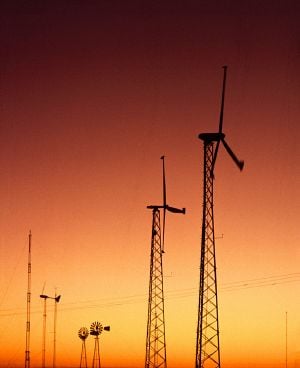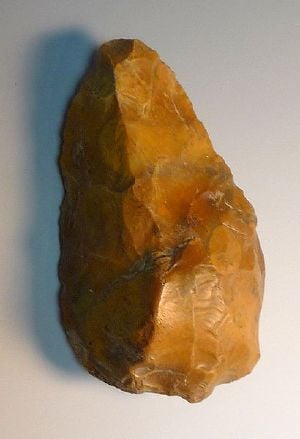Machine
- This article is about devices that perform tasks.
The scientific definition of a machine is any device that transmits or modifies energy. In common usage, the meaning is restricted to devices having rigid moving parts that perform or assist in performing some work. Machines normally require some energy source ("input") and always accomplish some sort of work ("output"). Devices with no rigid moving parts are commonly considered tools, or simply devices, not machines.
People have used mechanisms to amplify their abilities since before written records were available. Generally these devices decrease the amount of force required to do a given amount of work, alter the direction of the force, or transform one form of motion or energy into another.
Modern power tools, automated machine tools, and human-operated power machinery are tools that are also machines. Machines used to transform heat or other energy into mechanical energy are known as engines.
Hydraulics devices may also be used to support industrial applications, although devices entirely lacking rigid moving parts are not commonly considered machines. Hydraulics are widely used in heavy equipment industries, automobile industries, marine industries, aeronautical industries, construction equipment industries, and earthmoving equipment industries.
History
Perhaps the first example of a human made device designed to manage power is the hand axe, made by chipping flint to form a wedge. A wedge is a simple machine that transforms lateral force and movement of the tool into a transverse splitting force and movement of the workpiece.
The idea of a simple machine originated with the Greek philosopher Archimedes around the third century B.C.E., who studied the Archimedean simple machines: lever, pulley, and screw. However the Greeks' understanding was limited to statics (the balance of forces) and did not include dynamics (the tradeoff between force and distance) or the concept of work.
During the Renaissance the dynamics of the Mechanical Powers, as the simple machines were called, began to be studied from the standpoint of how much useful work they could perform, leading eventually to the new concept of mechanical work. In 1586 Flemish engineer Simon Stevin derived the mechanical advantage of the inclined plane, and it was included with the other simple machines. The complete dynamic theory of simple machines was worked out by Italian scientist Galileo Galilei in 1600 in Le Meccaniche ("On Mechanics"). He was the first to understand that simple machines do not create energy, they merely transform it.
The classic rules of sliding friction in machines were discovered by Leonardo da Vinci (1452–1519), but remained unpublished in his notebooks. They were rediscovered by Guillaume Amontons (1699) and were further developed by Charles-Augustin de Coulomb (1785).
Mechanical advantage and efficiency
The mechanical advantage of a simple machine is the ratio between the force it exerts on the load and the input force applied. This does not entirely describe the machine's performance, as force is required to overcome friction as well. The mechanical efficiency of a machine is the ratio of the actual mechanical advantage (AMA) to the ideal mechanical advantage (IMA). Functioning physical machines are always less than 100 percent efficient.
Types
| Classification | Machine(s) | |
|---|---|---|
| Simple machines | Inclined plane, Wheel and axle, Lever, Pulley, Wedge, Screw | |
| Mechanical components | Axle, Bearings, Belts, Bucket, Fastener, Gear, Key, Link chains, Rack and pinion, Roller chains, Rope, Seals, Spring, Wheel | |
| Clock | Atomic clock, Watch, Pendulum clock, Quartz clock | |
| Compressors and Pumps | Archimedes' screw, Eductor-jet pump, Hydraulic ram, Pump, Trompe, Vacuum pump | |
| Heat engines | External combustion engines | Steam engine, Stirling engine |
| Internal combustion engines | Reciprocating engine, Gas turbine | |
| Heat pumps | Absorption refrigerator, Thermoelectric refrigerator, Regenerative cooling | |
| Linkages | Pantograph, Cam, Peaucellier-Lipkin | |
| Turbine | Gas turbine, Jet engine, Steam turbine, Water turbine, Wind generator, Windmill | |
| Aerofoil | Sail, Wing, Rudder, Flap, Propeller | |
| Information technology | Computer, Calculator, Telecommunications networks | |
| Electricity | Vacuum tube, Transistor, Diode, Resistor, Capacitor, Inductor, Memristor, Semiconductor | |
| Robots | Actuator, Servo, Servomechanism, Stepper motor | |
| Miscellaneous | Vending machine, Wind tunnel, Check weighing machines, Riveting machines | |
ReferencesISBN links support NWE through referral fees
- Boothroyd, Geoffrey and Winston A. Knight. 2005. Fundamentals of Machining and Machine Tools, Third Edition (Mechanical Engineering (Marcell Dekker)). Boca Raton, FL: CRC. ISBN 1574446592
- Myszka, David H. 1998. Machines and Mechanisms: Applied Kinematic Analysis. Upper Saddle River, NJ: Prentice Hall. ISBN 0135979153
- Oberg, Erik, Franklin D. Jones, Holbrook L. Horton, and Henry H. Ryffel. 2000. Machinery's Handbook. New York, NY: Industrial Press Inc. ISBN 0831126353
- Usher, Abbott Payson. A History of Mechanical Inventions. Dover Publications, 2011. ISBN 978-0486255934
| ||||||||||||||||||||||||||
Credits
New World Encyclopedia writers and editors rewrote and completed the Wikipedia article in accordance with New World Encyclopedia standards. This article abides by terms of the Creative Commons CC-by-sa 3.0 License (CC-by-sa), which may be used and disseminated with proper attribution. Credit is due under the terms of this license that can reference both the New World Encyclopedia contributors and the selfless volunteer contributors of the Wikimedia Foundation. To cite this article click here for a list of acceptable citing formats.The history of earlier contributions by wikipedians is accessible to researchers here:
The history of this article since it was imported to New World Encyclopedia:
Note: Some restrictions may apply to use of individual images which are separately licensed.

